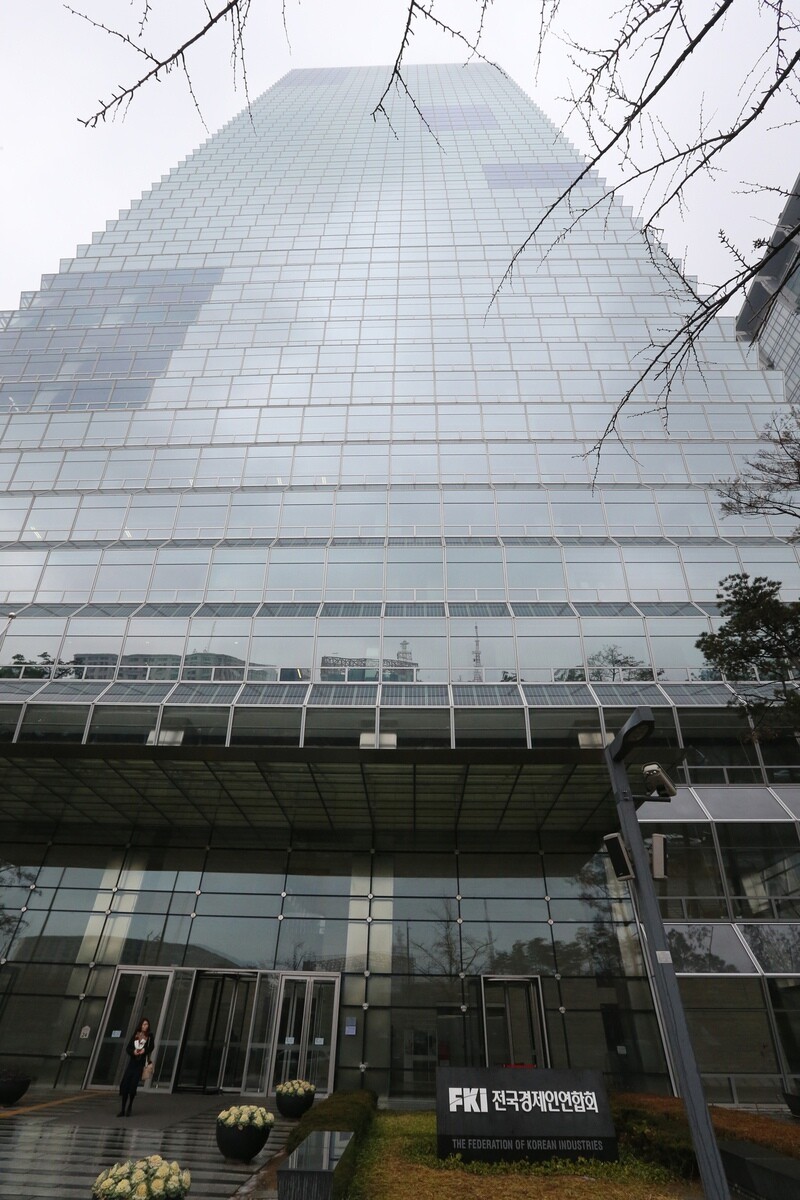hankyoreh
Links to other country sites 다른 나라 사이트 링크
Study finds 31 chaebols control 2/3 of facilities investment and exports

A new study has found that the 31 largest chaebols in Korea (by assets) account for two-thirds of the South Korea’s facilities investment and exports, as well as close to half of R&D investment, donations and market capitalization.
The Korea Economic Research Institute (KERI, Director Gwon Tae-shin), a subsidiary of the Federation of Korean Industries (FKI), reported on August 19 that the 31 largest chaebols in Korea, which own assets worth at least 10 trillion won (US$8.92 billion) and are subject to restrictions on mutual investment, accounted for 66.3 percent of Korea’s exports last year. The average figure between 2015 and 2017 stood at 64 percent.
In terms of facilities investment, the top 31 chaebols accounted for 135.5 trillion won (US$120.92 billion), which represents 71.4 percent of the 189.8 trillion won (US$169.35 billion) in total facilities investment stated in a report by the Industrial Bank of Korea. In 2016, these companies also made up 51.4 percent of all corporate donations with 2.4 trillion won (US$2.14 billion), and 45.5 percent of private sector investment in R&D with 24.5 trillion won (US$21.86 billion). The combined market capitalization of the 186 subsidiaries under the umbrella of these 31 chaebols amounted to 1.13 quadrillion won (US$1.01 trillion) as of last year, making up 59.5 percent of the total.
Finally, added value created by these chaebols accounted for 13.5 percent of Korea’s GDP, a one percentage point increase over the 10.4 percent recorded in 2014. This suggests that the concentration of economic power in chaebols continues to grow.
“The chaebol groups are leading Korea’s economic development and playing an important role in boosting the people’s quality of life,” said Yoo Hwan-ik, the head of innovative growth at KERI. “If the government wants to make innovative growth a success, it should reconsider its policy of regulating chaebols and create a business environment that allows all companies to invest as much as they like.”
In the past, the FKI has been relatively passive in response to studies on chaebol domination of the national economy, fearing criticism over the concentration of economic power. However, the change in attitude on this occasion has been spurred by Deputy Prime Minister and Minister of Economy and Finance Kim Dong-yeon’s focus on innovative growth, including direct visits to the four largest corporate groups. These groups have now responded by coming out with investment and hiring plans in line with the new policy, which analysts view as a strategic move to pave the way for regulatory easing.
By Kwack Jung-soo, Business correspondent
Please direct comments or questions to [english@hani.co.kr]

Editorial・opinion
![[Column] Has Korea, too, crossed the Rubicon on China? [Column] Has Korea, too, crossed the Rubicon on China?](https://flexible.img.hani.co.kr/flexible/normal/500/300/imgdb/original/2024/0419/9317135153409185.jpg) [Column] Has Korea, too, crossed the Rubicon on China?
[Column] Has Korea, too, crossed the Rubicon on China?![[Correspondent’s column] In Japan’s alliance with US, echoes of its past alliances with UK [Correspondent’s column] In Japan’s alliance with US, echoes of its past alliances with UK](https://flexible.img.hani.co.kr/flexible/normal/500/300/imgdb/original/2024/0419/2317135166563519.jpg) [Correspondent’s column] In Japan’s alliance with US, echoes of its past alliances with UK
[Correspondent’s column] In Japan’s alliance with US, echoes of its past alliances with UK- [Editorial] Does Yoon think the Korean public is wrong?
- [Editorial] As it bolsters its alliance with US, Japan must be accountable for past
- [Guest essay] Amending the Constitution is Yoon’s key to leaving office in public’s good graces
- [Editorial] 10 years on, lessons of Sewol tragedy must never be forgotten
- [Column] A death blow to Korea’s prosecutor politics
- [Correspondent’s column] The US and the end of Japanese pacifism
- [Guest essay] How Korea turned its trainee doctors into monsters
- [Guest essay] As someone who helped forge Seoul-Moscow ties, their status today troubles me
Most viewed articles
- 1[Column] The clock is ticking for Korea’s first lady
- 2Hong Se-hwa, voice for tolerance whose memoir of exile touched a chord, dies at 76
- 3[Column] Has Korea, too, crossed the Rubicon on China?
- 4After 2 months of delayed, denied medical care, Koreans worry worst may be yet to come
- 5[Correspondent’s column] In Japan’s alliance with US, echoes of its past alliances with UK
- 6US overtakes China as Korea’s top export market, prompting trade sanction jitters
- 7All eyes on Xiaomi after it pulls off EV that Apple couldn’t
- 8[Photo] Smile ambassador, you’re on camera
- 9Samsung barricades office as unionized workers strike for better conditions
- 10S. Korea “monitoring developments” after report of secret Chinese police station in Seoul